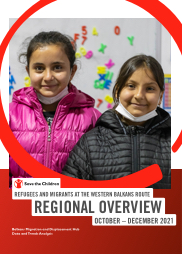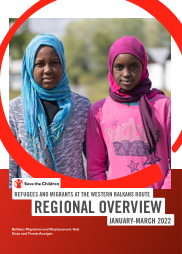
Briefs, Fact Sheets and Brochures, Reports
Balkans Migration and Displacement Hub Data and Trend Analysis: Regional overview October – December 2021
Publication year:
2022
English
Format:
(1.5 MiB)
Publisher:
Save the Children International,Save the Children North West Balkans
Data and Trend Analysis (DATA) Refugees and Migrants at the Western Balkans Route Regional Overview October– December 2021 describes key trends in migrations in the region, detailing information about the number of people on the move, demography (age, sex, country of origin, etc), behavioral patterns, and routes in use – with a focus on children, particularly unaccompanied children.
Key trends showcased in this report:
- The Balkans migration route has seen the largest increase in the number of arrivals recorded on the major Mediterranean routes in 2021 compared to 2020. Despite a slight decline in the last three months of 2021, the year has seen a 124% increase in detected border crossings compared to 2020.
- 8,677 refugees and migrants in the Western Balkans countries at the end of 2021, representing a slight (19%) decrease compared to Q3 2021. Similar to the Q3, Serbia was at the forefront with most refugees and migrants in its territory, followed by Bosnia and Herzegovina.
- The main countries of origin of the new arrivals remained the same as in the previous quarter – Afghanistan (30%), Syria (16%) and Pakistan (13%).
- The last quarter of the year was marked by a somewhat increased number of Cubans seeking asylum in many countries on the route, especially in Montenegro, North Macedonia, and Greece.
- Burundians were another large group of asylum seekers arriving in Serbia in the same manner; by the end of the year, they were the most numerous in the asylum centre in Belgrade and submitted the most asylum applications.
- Just like it started, 2021 ended with reports on collective expulsions (pushbacks). An increasing number of media reports revealed the unlawful practices by the authorities in Croatia, Greece and Romania, expelling migrants and refugees arriving at their borders seeking refuge without providing them access to asylum.
Read full abstract
Authors
View & Download
Document information
Authors
Content type
Country
Region
Topics
Rights
© Author/Publisher
Found a mistake? Help us improve!
If you have noticed a document assigned to the wrong author or any other inaccuracies, let us know! Your feedback helps us keep our data accurate and useful for everyone.
Share
Link

